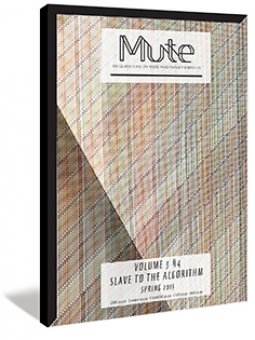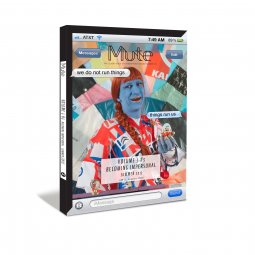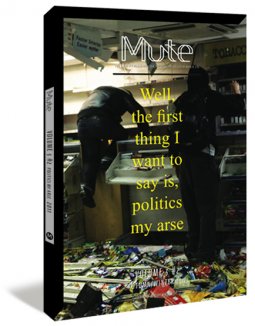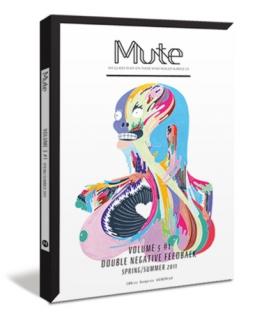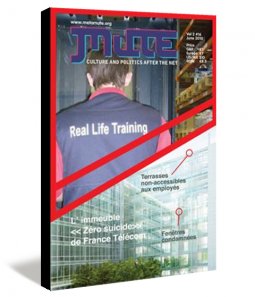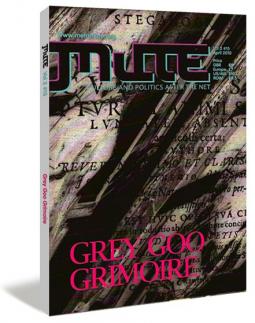Magazine
Buy on Amazon UK £9.99 and other regions, Super Saving free shipping.
Featuring: Manifesto for a Theory of the ‘New Aesthetic’ - An irreverent guided tour of the ‘New Aesthetic’ by Curt Cloninger | The Missing Factory - John Roberts considers why work remains absent from film and culture more generally | Barbara Says – Industry Does it Faster - Roman Vasseur reviews the Artist Placement Group’s historic brokerage of bureaucracy and art | The Ghosts of Participation Past - Josephine Berry Slater reviews Claire Bishop’s recent book, Artificial Hells | Listener As Operator 3 - Howard Slater finds in jazz a response to the experience of slavery which preserves and propels a collective being | Untitled #m001-#m011, 2,325,600 combinations of 16 grays, an artist’s project by John Houck | Gaming the Plumbing | Alberto Toscano inspects the gap between financial fantasies and the muddy realities of the ‘robot phase transition’ | Destructive Destruction? - How is high frequency trading’s drive to efficiency affecting market dynamics as a whole? Ask Inigo Wilkins and Bogdan Dragos | Fellowship of the Wrong - A code-splitting tale of lightspeed trading run by Benedict Seymour, with illustrations by Rona Tunnadine | The Guest - A short story by Mira Mattar exploring the annihilating power of luxury | The Garden of Earthly Delights - Matthew Fuller wades through the Olympic muck to visit The Crystal World | At the Limit: Self-Organisation in Greece - Anna O’Lory of Blaumachen identifies some limits to current struggles in Greece | Whose Rebel City? - Neil Gray discusses David Harvey’s Rebel Cities from the perspective of the autonomous urban struggles of ’70s Italy
2013-04, ISSN 1356-7748-304 & ISBN 9781906496043
FURTHER DESCRIPTION
As the financial crisis fastens its grip ever tighter around the means of human and natural survival, the age of the algorithm has hit full stride. This phase-shift has been a long time coming of course, and was undoubtedly as much a cause of the crisis as its effect, with self-propelling algorithmic power replacing human labour and judgement and creating event fields far below the threshold of human perception and responsiveness. But, as the articles in this issue by Alberto Toscano, Bogdan Dragos & Inigo Wilkins, and Benedict Seymour relate, the adoption of algorithmic tools begun by financial traders in the 1990s has expanded exponentially since 2008 in response to the intensified profits crisis as much as the maturation of tools. Toscano [p. 68] soberingly illustrates the effects of this shift: ‘In 1945, US stock was held on average for four years; this dropped to eight months in 2000, two months in 2008, and 22 seconds in 2011.’ So algorithms are widely experienced as the replicant horsemen of the apocalypse, swarming through and clogging up markets in their pursuit of tradeable differentials, creating an endless churn of shares which foreclose longer term investment strategies, dangerously automating the assessment of risk and precipitating ‘flash crashes’, hitting labour markets as supply chain management systems react at light-speed to human or material frictions, sucking up huge financial and energy resources to construct the data infrastructures they require, and even creating tens of thousands of unemployed traders as this elite profession falls victim to its own drive towards efficiency.
But our enslavement to the algorithm has as much to do with our conceptions of it as our replacement by it or, better, the capitalist nature of this replacement. Toscano references a literature of ‘materialist micro-sociology’ which opens up the black-box of high frequency trading (HFT) to grasp it as a product of ‘institutional struggles’ over the fixing of legal and technical parameters, and not just the cognitively unmappable computational acceleration and automation of mathematics. In his short story [p.94], Seymour imagines a non-capitalist use of algorithms which are simply given a different aim – to solve mankind’s dependency on the value form and hydro-carbons, nix climate change and improve the sum of human happiness – thereby recentering the human and ‘enslaving’ the algorithm to the needs of mortals. Dragos & Wilkins [p.80] highlight a different finality to HFT than the chaos inducing repetition compulsion of the algorithm itself, namely that of high entropy and noise saturation peaks. As with all isolated systems, they argue, the market is ruled by the second law of thermodynamics which states that entropy will tend towards a maximum.
HFT’s attempts to eradicate information differentials (e.g. bid-ask spreads) end up offsetting more noise/entropy onto the system as a whole, as it ‘browns out’ the networks with price requests and the sub-millisecond turnover of trades. If the first two writers stress the algorithm’s operation within the logic of capitalism, one which as Marxists they also understand as both an effect and imprisonment of the human development of reason, Dragos & Wilkins widen the focus to think about how HFT is also determined by natural and physical forces; how capitalism precipitates high entropy. While none of these analyses understand algorithmic behaviour as strictly ‘out of control’, they do nevertheless diverge around the contextual frame in which its autonomising force can be understood. For Toscano and Seymour, algorithms exist within a human driven techno-social development which has unleashed the autonomising power of exchange value. For Dragos & Wilkins, the human evolves as much within the ontological sway of technology – amongst other physical, chemical and biological processes – as vice versa.
The ways in which capital’s will to autonomy meets material limits, and the material realm is reciprocally shaped by the forces of abstraction, is naturally as much a problem for city dwellers, farmers, artists, anti-capitalists and philosophers as capitalists themselves. Returning to Marx, Toscano reminds us that the more production is driven byexchange value and hence exchange, the more the physical conditions of circulation become a problem for capital in its bid to ‘annihilate’ space through time. Similarly, Dragos & Wilkins point out that the (paradoxical, because inimical to profit) pursuit of total efficiency or ‘zero information friction’ results ‘in the non-dialectical destruction of whole swathes of economic actors largely at the base of steep energy gradients’.
This ‘resurgence’ of the physical sees, for instance, finance capital blasting holes through the Allegheny Mountains to lay fibre optic cables to shave sub-millisecond times off trades between Chicago and New York. It also sees the migration of circulating capital into real estate speculation and rent extraction – discussed by Neil Gray in his extended review of David Harvey’s Rebel Cities [p.126] – during capitalism’s long profits crisis from the early ’70s until today. A ‘spatial fix’ which impacts in the material realm of social reproduction, with more or less insubordinate results across the decades. In both scenarios, automatic intensification causes the resurgence of material frictions: the physical terrain that circulating commodities or trades must cross as much as the social and physical densities of cities.
Artists are likewise provoked by the compulsive effects of automation upon the visual realm. John Houck, who has made this issue’s cover and artist’s project, has spoken of his desire to pierce virtual objects and their recursiveness. ‘I wanted to reclaim them and make them physical’, he said in an interview for Lay Flat magazine, ‘[...] To overlay an intuitive system on a combinatorial system was the way out of the dead end of a predictable notational system.’ And in his article on the so-called New Aesthetic – a term given to the involuntarily aesthetic effects arising from networked computational and technological assemblages – Curt Cloninger insists on the aesthetic as residing in the affective responsiveness of humans and not within any notional aesthesis of the inorganic.
The escalating circularity between technological intensification and capitalist omnicrisis has become an oppressive and bewilderingly abstract battleground upon which the question of social survival, aims and values is being fought out. To what degree do we see reasoning and technological systems as autonomous from human determination? Can human society challenge its domination by abstract systems (of value) to create new, non-lethal ones? To what degree are we symbiotically integrated with them? How are they extending the limits of humanness or preventing its necessary development? When John Houck folds the print-out of a software driven index graph, re-photographs it and then adds a digital fold, can we still tell the difference between the two folds? Does the manual act of folding do something more than create a delusional sense of the human empowerment to affect our conditions? Or is exerting force against virtual systems, without fantasising our release from them, something we need to learn to do as elegantly as Houck?
Josephine Berry Slater <josie@metamute.org> is Editor of Mute
TABLE OF CONTENTS
Manifesto for a Theory of the ‘New Aesthetic’
By Curt CloningerThe Missing Factory
By John RobertsBarbara Says — Industry Does it Faster
By Roman VasseurThe Ghosts of Participation Past
By Josephine Berry SlaterListener As Operator (3)
By Howard SlaterGaming the Plumbing: High-Frequency Trading and the Spaces of Capital
By Alberto ToscanoDestructive Destruction? An Ecological Study of High Frequency Trading
By Inigo Wilkins & Bogdan DragosFellowship of the Wrong
By Benedict SeymourThe Guest
By Mira MattarThe Garden of Earthly Delights
By Matthew FullerAt the Limit: Self-Organisation in Greece
By Anna O'LoryWhose Rebel City?
By Neil GrayThe ways in which the personal can be grasped as political is an exponentially productive legacy of second wave feminism. This idea connects the arguments made by many of the writers in this issue: Clinical Wasteman considers the all too personal experience of impersonal systems of exploitation but equally, and against communitarian fantasies, the need to think all imaginable futures as only socially, not privately, producible; in Occupy, Nick Thoburn discovers a collective exposure and deprivatisation of the privatised hells of living through austerity; and P. Valentine exposes the social function of the intimate ordeal of sexual violence. Maintaining conceptual and experiential distinctions, or f ire walls, between the personal and the impersonal, the domestic and the political, both within the mainstream and on the left, is exposed as actively constitutive of the system as a whole.
2012-08, ISSN 1356-7748-303 & ISBN 9781906496869
TABLE OF CONTENTS
Editorial Mute 3 #3
By Josephine Berry SlaterMinor Politics, Territory and Occupy
By Nick ThoburnProtektorama Smartfonhexe
By Johannes Paul RaetherOrgy of the Non/Self
By Josephine Berry SlaterNo Interest But the Interest of Breathing
By Clinical WastemanGeraldine Goat – The Hard Way To Enlightenment
By Katrina PalmerEveryone Has a Business Inside Them
By Marina VishmidtFrom the Cult of the People to the Cult of Rancière
By Anthony Iles and Tom RobertsThe Gender Rift in Communisation
By P. ValentineSelf-Compression: An Interview with Jesse Darling
By Tom Clark and Rózsa FarkasBitcoin – finally, fair money?
By The Wine and Cheese Appreciation Society of Greater London and Scott LenneyBloomsbury Olympic
By Richard Braude'Well, the first thing I want to say is, politics my arse' Issue 2 includes: cover art by Johnny Spencer * Alberto Toscano on logistics and anarchism * Gail Day on postmodernism at the V&A * Brian Ashton zooms in on RFID * Mark Neocleous on generalised anxiety * Benjamin Noys on spaghetti communism * Howard Slater on the August riots * Mme Tlank and Mira Mattar on motherly love, care and capital * Stefan Szczelkun on Gregory Sholette's book, Dark Matter * Anustup Basu on the Arab Spring * Sander on why China won't save capitalism
2012-02, ISSN 1356-7748-302 & ISBN 9781906496029
TABLE OF CONTENTS
Editorial Mute 3 #2
By Josephine Berry SlaterWhat Next For Education Struggles
By Sarah TaylorStreet Writing Observatory
By Mute All StarsUnlimited Liability or Nothing to Lose?
By Clinical WastemanLogistics and Opposition
By Alberto ToscanoWhat the RFID is That?
By Brian AshtonAnxious Resilience
By Mark NeocleousSpaghetti Communism?
By Benjamin NoysFTH: The Savage and Beyond
By Howard SlaterPast Caring
By Madame Tlank and Mira MattarRiot Polit-Econ
By Khalid Qureshi Foundation and Chelsea Ives Youth CentreThe Dark Arts
By Stefan SzczelkunStyle Without Subversion
By Gail DayReflections on the Arab Spring
By Anustup BasuThe Illegitimacy of Demands
By Dimitra KotouzaWill China Save Global Capitalism?
By Sander'Double Negative Feedback' expresses the hope that the chaos unleashed by the cybernetic loops of financialisation, post-Fordist production and networked life might not only be entropic and exploitative. The noise generated by 'positive feedback' also takes the form of the explosions we are seeing in the Arab world, the anti-disciplinary uses of cybernetic control systems, the 'shared precarity' of compositional improvising, and the ripples of a political organising that no longer assumes a common identity but instead acknowledges our common vulnerability. This issue scouts out such double-negative loops in a landscape dominated by the relentless, if often misfiring attempt to put feedback to work
2011-06, ISSN 1356-7748-301 & ISBN 9781906496012
FURTHER DESCRIPTION
100% Arts Cut
Pauline van Mourik Broekman's personal consideration of Mute's defunding
In the Mud and Blood of networks
Anthony Iles interviews Graham Harwood
Zaha Hadid Architects and the Neoliberal avant-garde
Owen Hatherley takes a look at the fluid architecture and financial times of Zaha Hadid Architects
Music is the Crime that Contains All The Others
Demetra Kotouza on the rebel sounds of Rebetiko
Anti-Disciplinary Feedback and the Will to Effect
Lars Bang Larsen reads counter-cultural 'good vibration' literally and politically
The Light Years: Contemporary Art in the Age of Weightless Capital
Anna Dezeuze on the loaded lightness of 'precarious art'
Listener as Operator
Howard Slater on the 'compositional improvising' in Jazz and beyond
Artist's Project
by Mimi Lueng
On Coca to Capital
John Barker on first world junkie-capitalism
ISSN 1356-7748-301
ISBN 978-1-906496-01-2
Dimensions: 178 x 254 x 17 mm
176 pages
TABLE OF CONTENTS
Mute's 100% cut by ACE - a personal consideration of Mute's defunding, by co-founder Pauline van Mourik Broekman
By Pauline van Mourik BroekmanEditorial - Mute magazine, volume 3 #1
By Josephine Berry SlaterFrequently Asserted Fallacies of the Crisis and How to Quash Them
By ContributorsContain This! Leaks, Whistle-Blowers and the Networked News Ecology
By Felix StalderZaha Hadid Architects and the Neoliberal Avant-Garde
By Owen HatherleyBody Bomb - Artist's project by Mimi Leung
By Mimi LeungThe Light Years: Contemporary Art in the Age of Weightless Capital
By Anna DezeuzeMusic is the Crime that Contains All Others
By Demetra KotouzaFordism? Who's that For, Men Only?
By Noreen MacDowellClio Barnard's Talking Heads
By Omar El-KhairyOccultural Studies 2.0: Passionate Divas
By Eugene ThackerListener as Operator
By Howard SlaterDear Living Person
By John RussellAnti-Disciplinary Feedback and the Will to Effect
By Lars Bang LarsenShort Circuits: Finance, Feedback and Culture
By Benedict SeymourFrom Coca to Capital: Free Trade Cocaine
By John BarkerIn the Mud and Blood of Networks: An Interview with Graham Harwood
By Anthony IlesIn this issue of Mute we look at the systemic requirement to appear, to have an identity, to become intelligible - as an individual, a face, a body, a set of affects, a data-set within biopolitical capitalism. This recurrent demand to appear is both extracted and seduced out of us by the apparatuses of state and spectacle; the system of property and images; the simultaneous need to harness labour and manage the unemployed. In this issue we also look at the deeper shifts in capitalism which trigger the intensifying management of life; a crisis of abundance is brought on by industrial and technological developments converting the majority of the earth's inhabitants into a ‘surplus' population to be managed and ‘warehoused' in jails, workfare schemes or that open prison known as Web 2.0.
2010-06, ISSN 1356-7748-216 & ISBN 9781906496494
FURTHER DESCRIPTION
On Edge
Stefan Szczelkun talks to artist Alexa Wright about how her work breaks down the self
Rumours of War
Paul Helliwell rhythmanalyses Steve Goodman's Sonic Warfare and the group work Noise and Capitalism
Artificial Scarcity in a World of Overproduction: An Escape that isn't
The 'production of innovation', write Sander, is no replacement for the production of value
Eliminating Labour:Aesthetic Economy in Harun Farocki
Benedict Seymour on devalorisation in a high-tech cinematic oeuvre
Artist's Project: The Wealth of Negations
by CVA Group
Clandestinity and Appearance
John Cunningham takes up the case of clendestinity and resistance in the age of biopolitics
Is the Brickburner Still the Same
Neinsager opens and shuts dissident writer and migrant labourer B.Traven's identity file
Casa Pound and the New Radical Right in Italy
The Moyote Project discusses the strange case of fascists imitating anarchists to popular effect
University Struggles at the End of the Edu-Deal
George Caffentzis pieces together an emerging plane of struggle
Illustrations
Alexa Wright, Harun Farocki, Mongrel
ISSN 1356-7748-21
ISBN 978-1-906496-49-4
Dimensions: 22.4 x 15.2 x 1.3 cm
120 pages
TABLE OF CONTENTS
On Edge
By Stefan SzczelkunRumours of War
By Paul HelliwellArtificial Scarcity in a World of Overproduction: An Escape that Isn't
By SanderEliminating Labour: Aesthetic Economy in Harun Farocki
By Benedict SeymourThe Wealth of Negations
By CVA GroupClandestinity and Appearance
By John CunninghamIs the Brickburner Still the Same?
By NeinsagerCasa Pound and the New Radical Right in Italy
By Moyote ProjectUniversity Struggles at the End of the Edu-Deal
By George Caffentzis'Grey Goo’ is a hypothetical end-of-the-world scenario involving molecular nano-technology in which out-of-control self-replicating robots consume all matter on Earth while building more of themselves. This spectacularly dystopian meme not only provides a Sci Fi analogue for the carnage reaped by capital accumulation, but also conceives of its residue – a world not definitively destroyed, but degenerated into a mass of undifferentiated, yet still active goo. The goo’s combination of inhuman self-replication and destruction is an instance of how the pop imaginary conceives of The End. Not as an interruption ushering in the transvaluation of all values, but as an infinite extension of more of the same old shit. Writers in this issue of Mute also recognise the likelihood of this gooey scenario in which crisis doesn’t automatically release us from our current conditions but may well simply deepen them. Soberly examining the general deployment of endings, from Hollywood disaster movies to anti-capitalist theory to the manipulation of climate-change panic, this issue of Mute puts an end to the endgames.
2010-04, ISSN 1356-7748-215 & ISBN 9781906496456
FURTHER DESCRIPTION
Crisis at the ICA
J.J. Charlesworth on why the ICA's crisis is not an accident of recession
An End Without End
Evan Calder Williams takes aim at Hollywood's world-affirming vision of The End
Apocalypse, Tendency, Crisis
Benjamin Noys urges us to rethink radical theory's apocalyptical tone
Post-Crunch Futures (Part II)
We continue our fiction series extrapolating the impact of the credit crunch and techno-capitalism into a deadly near future − with stories by Matthew Fuller and Anthony Iles
Artist's Project: Steganographia
By Martin Howse
How Not To Be an Atheist
Ben Pritchett picks apart the jumbled relation between ethics, new media and subjectivity
Hung, Drawn and Quartered
Owen Hatherley on 'urban renaissance' and its discontents, and its not-so-discontents
Against Representation
Noise artist Mattin probes the enigma of radical performativity
Hopenhagen Against Hope
Ilya Lipkin on COP15's attempt to commodify disaster and hope
Illustrations
Tim Goldie, Caroline Heron
ISSN 1356-7748-215
ISBN 978-1-906496-45-6
Dimensions: 22.4 x 15.2 x 1.3 cm
134 pages
TABLE OF CONTENTS
Crisis at the ICA: Ekow Eshun's Experiment in Deinstitutionalisation
By JJ CharlesworthAn End Without End: Catastrophe Cinema in the Age of Crisis
By Evan Calder WilliamsApocalypse, Tendency, Crisis
By Benjamin NoysPost-Crunch Futures II: A Mute Fiction Special
By Matthew Fuller and Anthony IlesSteganographia
By Martin HowseHow Not to be an Atheist
By Ben PritchettHung, Drawn and 'Quartered'?
By Owen HatherleyAgainst Representation: A Revolution in Front of You
By MattinHopenhagen against Hope
By Ilya LipkinMute Books Orders
For Mute Books distribution contact Anagram Books
contact@anagrambooks.com
For online purchases visit anagrambooks.com

